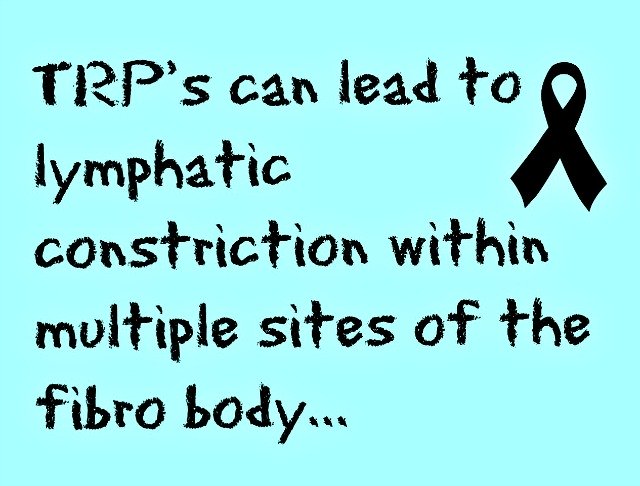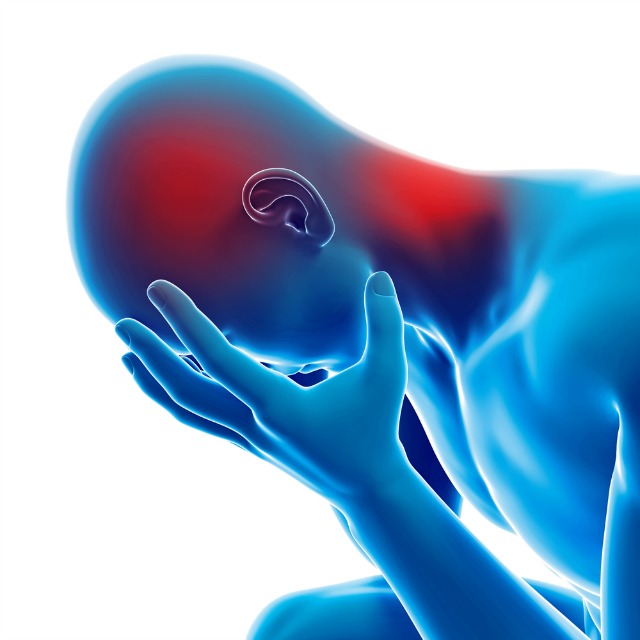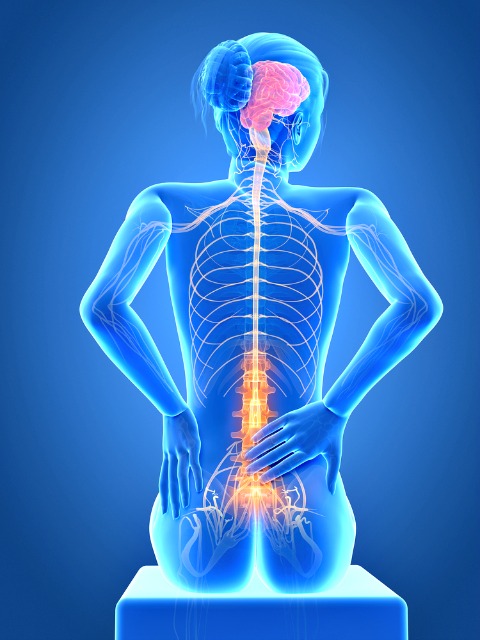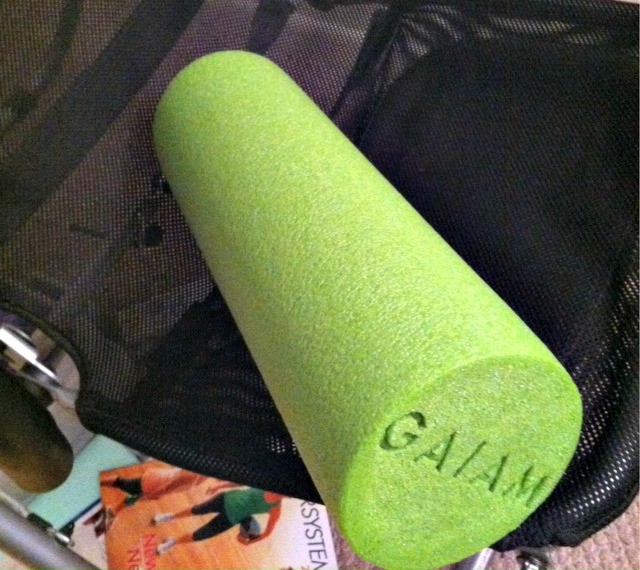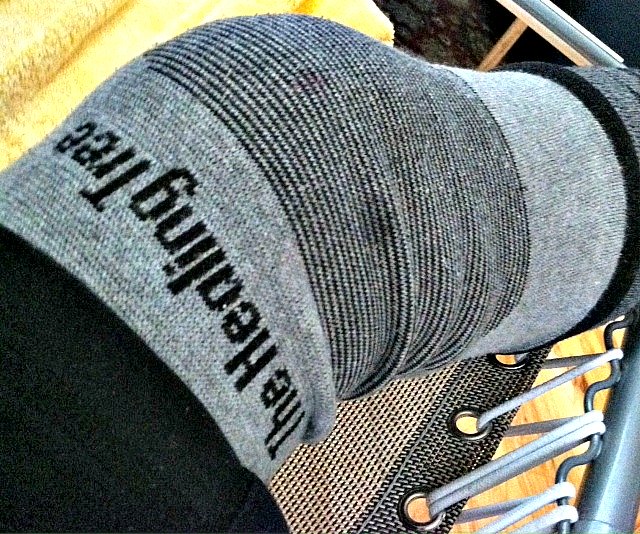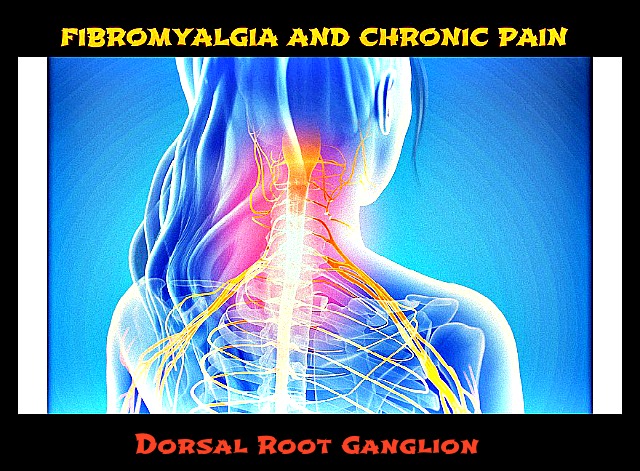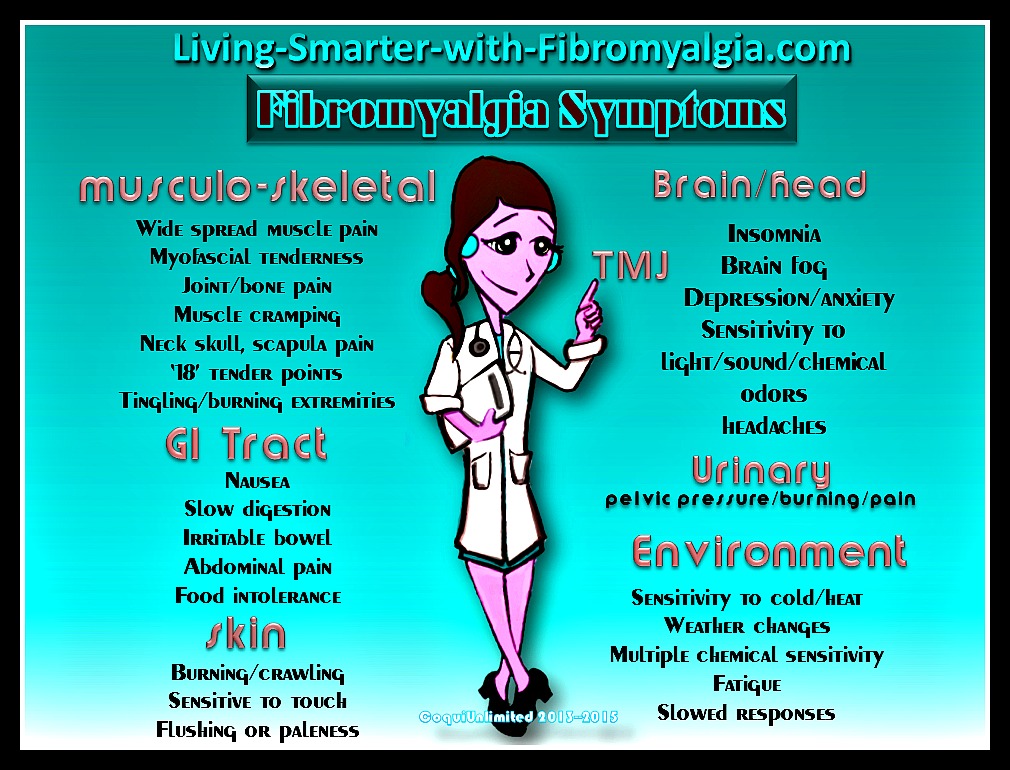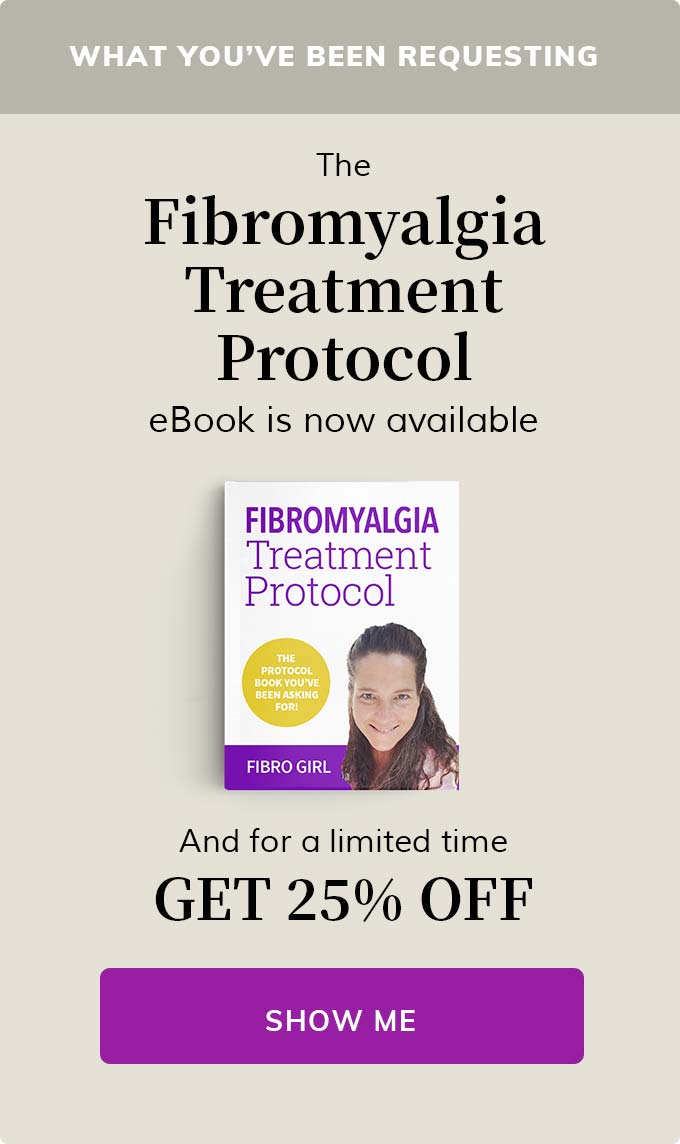Fibromyalgia Pain Is Unique

Fibromyalgia pain is unique due to its severity, complexity, and
multiple systems involved.
If you
have fibromyalgia, you know that chronic pain is just one of the myriad of
symptoms present within the fibro body at any one time.
See, there can be
multiple causes to a fibromyalgia headache for example, although the pain
itself occurs in the “fashion” we call fibromyalgia
pain.
It doesn’t matter if the headache started as neck or scapular-thoracic
pain OR if it was perpetuated by weather or exposure to some chemical toxins in
our environment. The pain is unique to fibromyalgia.
The stress pain that we fibro bodies feel is much the same when we are referring to fibromyalgia pain. It doesn’t matter if the stress that caused your nervous system to continually fire was from a negative or a positive experience.
The fibro body simply has a more difficult time regulating down the "fight or flight" reflex.
That continual stress on the body
wreaks havoc on our pain sensory system, and therein starts the cycle of
chronic fibromyalgia pain.
We know
there are various causes to developing fibromyalgia and chronic pain fibromyalgia,
but I do believe that many people simply have a greater propensity to developing fibromyalgia.
In fact, it has been shown that over 33% of fibro
suffers are genetically disposed to it. If you are like me, and your symptoms started at a young age, I am glad you are here.
I understand this condition, living with it, working with it, and helping others to attain a better quality of life, despite the complexity of fibromyalgia and its primary co-conditions.
The
pain and symptoms are never just in one area of the body. It is certainly not
ALL in your “headache”. It is not merely in your “frozen shoulder” or “restless
legs”.
No, the fibromyalgia pain
that a fibro person experiences is multi system and that is why we believe in a
multi-faceted approach to a better quality of life while living with not only
fibromyalgia but related conditions as well.
Myofascial pain is also related to
fibromyalgia and it is not uncommon to have both.
NOTE: This article covers fibromyalgia pain, but
for an overview of the fibromyalgia symptoms, refer to the SYMPTOMS LIST page here.
Pain in Hands Or Feet?
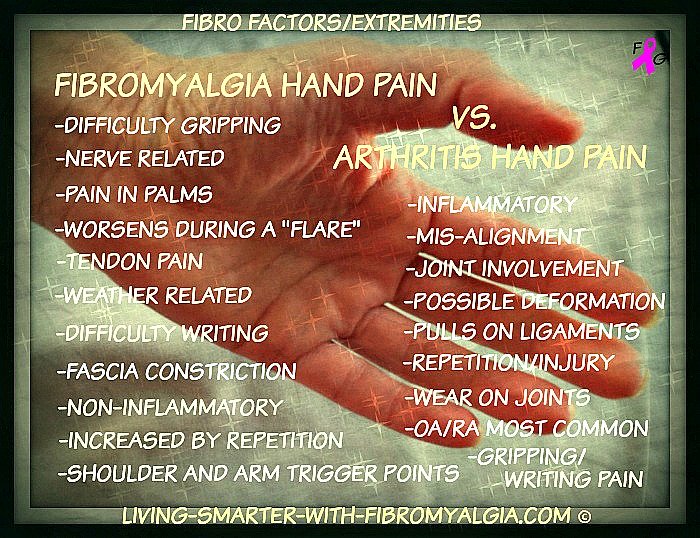 Fibromyalgia Pain In Hands & Feet
Fibromyalgia Pain In Hands & FeetThe
extremities are a common area for fibromyalgia
pain. Yet it is helpful to distinguish between other forms of pain in the
extremities.
Arthritis and/or nerve pain are associated with extremity pain but
fibromyalgia pain is unique in its ability to wax and wane, yet not always in
accordance to a weather pattern or stress.
It might simply happen that you wake
up one day and the same hand that was working well and flexible yesterday, may
be tight, stiff and/or burning.
It
might be difficult to open jars, tie shoes or put on clothing. Hand pain can
radiate into the forearm and elbows where there is a greater propensity for
tenderness and pain simply due to tender points around the elbow region.
Trigger
points around the shoulder can also radiate pain into the forearms and hands. You
may have restlessness in your hands where you feel the “need” to tap or move
your hands and/or fingers.
Try using copper compression gloves. The copper used in compression wear and clothing has been shown to reduce pain; it’s worth a try!! I use copper compression wear, clothing and gloves. I think it’s a good investment for long term use.
Try not to get too concerned when pain is “waxing”;
I know, that’s easier said than done. But I have personally experienced almost
debilitating hand pain during a period of time many years ago. I remember
talking to my D.C. about it, and my heightened concern about not being able to
use my hands the way I needed to.
That can be scary and disconcerting. The same
goes for pain in the legs and feet. See, every area of the fibro body has a
propensity to wax and wane in accordance to absolutely nothing…..but especially
in the extremities and/or around joints and tender points of the fibro body.
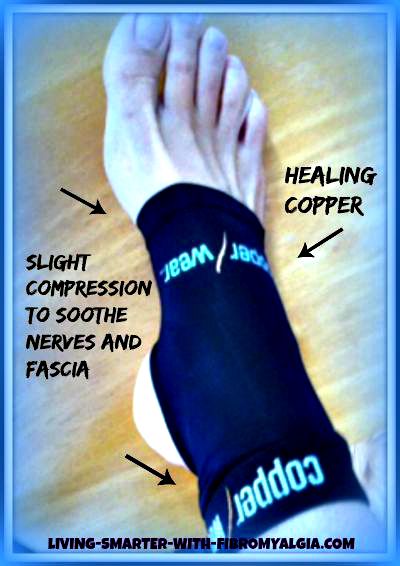 Copper Wear Compression For Fibro Foot Pain
Copper Wear Compression For Fibro Foot PainDue
to trigger points, fascia constriction and/or nerve related pain in the feet,
you might feel burning in both the top and bottom of the feet.
Myofascial
Release can be helpful when this pain is due to inactivity or constriction from
sitting, lying or being in one position for too long; however, this type of
work will vary regarding tolerance.
Refer to the
“myofascial release” article link at bottom of this page.
Another remedy I've found (and use) is copper wear compression ankle sleeves. This foot/ankle sleeve fits gently over the foot and the copper is healing. It provides very slight hugging compression support for diminished foot pain and improved foot structure.
Do you have restless legs? What about restless feet? There are various causes for restless and painful legs and feet. Nerve related
pain, fascia constriction or mineral deficiency are some common ones with
fibromyalgia.
Fibromyalgia Pain In The Upper Body
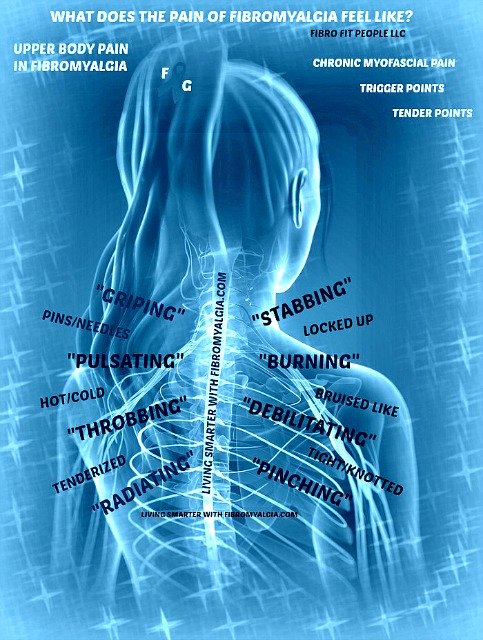 Fibro Upper Body Pain
Fibro Upper Body PainWe
have an entire article dedicated to upper back pain here in the website and
with fibromyalgia, that is pretty much a given. Burning scapular-thoracic pain
is one of the most unrelenting type of fibromyalgia
pain.
What about pain and tightness in the clavicle area below your
neckline? Tightness around the sternum is common as there are many trigger
points in this area around the subclavius and pectoralis muscles.
The only
consideration will be if pain is coming from another source unrelated to
fibromyalgia. It can be difficult to determine this but when other conditions
are ruled out, you can bet on fibromyalgia and/or myofascial pain being the
cause.
NOTE: A feeling of heaviness in the upper body can be due to chronic fatigue syndrome as well, and can
be associated with an inability to maintain an upright position for extended
periods of time.
Fluctuating blood pressure, heart palpitations and a feeling
of constriction in the chest are common with both fibromyalgia and chronic fatigue syndrome.
Be
careful not to exacerbate pain with shallow breathing. I often say that people
with chronic illness tend to be shallow breathers and this can intensify
tightness and even a choking feeling in the chest and throat area.
Sitting too
long at the computer or watching television can contribute to tightness in the
armpits and pectoralis muscles.
If you have Fibrocystic Breast Disease (FBD),
you may have waxing and waning of pain and tenderness not associated with
tender points but more so with lymphatic congestion and constriction. This pain
is closely associated to stress or repetitive motion in the arms and/or hands.
It
might take some trial and error to figure out what works for your severe upper body fibromyalgia pain, and even when you
find something that relieves pain today, it may not work the next time.
For
example, if you get regular massage for your fibromyalgia pain, but you ever find yourself becoming less
tolerant to massage that once felt good, you might need to change your approach,
technique or even avoid body massage for a period of time.
It might happen that
when you go back to it, that it is helpful again. At any rate, that is the
“nature” of fibromyalgia. Waxing, waning and the unpredictability of symptoms
can be most daunting when living with fibromyalgia.
Fibromyalgia Pain In The Lower Body
(Legs, Knees, & Hips)
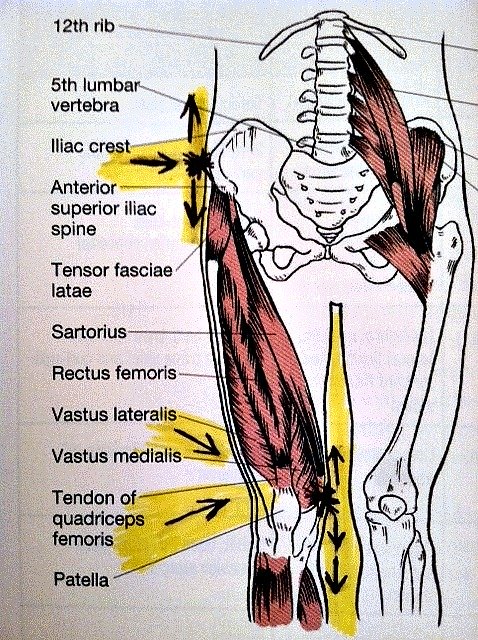 Fibro Lower Body Pain
Fibro Lower Body PainAnother common area for pain with fibromyalgia is in the legs and knees. The
interesting thing is that the first “pain zones” often related by a
patient when they recall back to the first signs of fibromyalgia are in the head
and upper body.
Leg pain comes readily after, likely due to the potential for
trigger points within layers of muscle in the lower body.
Everything works intimately together in the
lower quadrant of the fibro body. The hip bone really is “connected” to the
knee bone for instance when it comes to radiating pain and trigger points, due
to constriction, tightness and/or myofascial pain.
Both sitting and standing
for extended periods of time are not recommended when we have fibromyalgia
pain.
If you have a job where you are sitting, try to take breaks, be assertive when possible and also refer to the “pain in the butt” exercises I show on the Fibro Fit People page on facebook. (these are some simple exercises to perform in between sitting to help loosen and avoid increased propensity to pain and tightness.
Otherwise known as “FG’s side to side exercises”, because much of
what we do during the day is in a “forward” motion, such as walking and sitting.
Creating a greater range of motion is more appropriate for those who find
conventional stretching of the lower body difficult due to fibromyalgia pain
and/or other factors like arthritis.
Another
consideration is “Activities of Daily Living (ADLs)”. ADLs are different from
structured exercise and can also be an area where injury or increased pain can
easily occur. For instance, you might be going along feeling pretty decent, all
things considered, and then you have to lean down to clean the bathtub or mop
the floor.
All of a sudden, you might realize that these things are more
difficult than before. If some activity
or chore is too difficult without undue strain, we need to ask for assistance
where possible.
Fibromyalgia Pain and Headaches
We have an entire article here in the site dedicated to headaches and chronic migraine. This can be one of the most debilitating pain areas for a person with fibromyalgia. As I like to say, “this is where we think, express and interact with the world around us”.
If you have chronic head pain or migraine, then you know pain. The potential
for trigger points in the upper back/scapular area can easily turn pain in the
upper back into a migraine within a short period of time.
Stressors,
exposure to environmental toxins, sleeping position, seasonal allergies, food
allergies, and sinus or jaw (TMJ) pain can all increase pain within the fibro
body to the point of debilitation.
Again because there is nothing worse than
trying to think, work at a job, or enjoy the simple things in life when head
pain is pounding and radiating into your head, skull and face. It makes it even
more challenging to carry on a conversation or be social.
Having chronic migraine since the age of 9, I surely get it, and there are some things that we just cannot control. But throughout the website, we focus on the many variables that can contribute to headaches and other areas of fibromyalgia pain and the areas where we can be more proactive to at least lessen or decrease the severity of pain. (NOTE: Refer to headache article link below.)
Temperature Dysregulation
With fibromyalgia, there can be a few different root causes, and in addition there can be a dysfunction in the hypothalamus, pituitary and adrenal functions.
And although female hormones or lack thereof can also exacerbate temperature imbalance and hot flashes, we are talking more the everyday dysregulation in fibromyalgia itself.
Too much stress on the adrenals can increase adrenaline while also increasing temperature sensitivity.
The endocrine system is also affected by toxins in the environment, and when exposed to various things can cause the body to react with temperature dysregulation.
During or after a toxic exposure, your extremities can become very cold.
This is also why people with fibromyalgia often say it feels like living with flu symptoms 24/7.
There could also be an imbalance in thyroid or the presence of thyroid antibodies.
One day you might feel like you are sweating too much and yet another you could feel cold all day long at the same temperature.
Image Links To a few of our
"Pain" Articles
Click on any of the following “image links” to
get more detailed information for dealing with fibromyalgia pain in the areas
discussed above as well as others. When finished reading
the respective page, simply close it and you will be returned here, where you can checkout one of the other "pain" links here.
The following is an ad, not a link.
Before you leave, my sitemap can provide you with a "God's-eye" view of this website laid out in "outline format".
Stay connected by using the contact form below.
Home > Fibro Symptoms > Fibro Pain
Didn't find what you were looking for? Search for it:
living-smarter-with-fibromyalgia.com
©2013-2025 All Rights Reserved
FibroFitPeople, LLC ;©2025 All Rights Reserved


